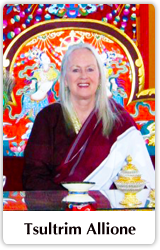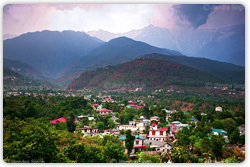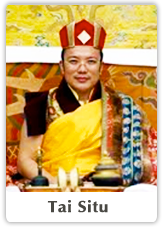Mira Prabhu's Blog, page 91
September 11, 2013
Demon of Eclipses & Illusions – Part 6/9
 As a farewell gift, Theo handed me an audio tape the evening he and Dana were to head back to their mountain home in Colorado. The subject was Chöd, translated as Feeding Your Demons, an ancient Tibetan healing practice; the woman teaching it was Lama Tsultrim Allione, one of the first American women to be ordained as a Tibetan nun.
As a farewell gift, Theo handed me an audio tape the evening he and Dana were to head back to their mountain home in Colorado. The subject was Chöd, translated as Feeding Your Demons, an ancient Tibetan healing practice; the woman teaching it was Lama Tsultrim Allione, one of the first American women to be ordained as a Tibetan nun.
Allione had been given her monastic vows by the Karmapa of the Karma Kagyu school of Tibetan Buddhism; she’d given back her vows four years later in order to marry. In 1993, she had founded Tara Mandala, a retreat center in southern Colorado. Her book Feeding Your Demons explores an approach based on the Chöd lineage of Machig Labdrön that Allione has practiced since 1973. “One does not become enlightened by imagining figures of light,” Allione quotes Jung, “but by making the darkness conscious.”
The practice of Chöd teaches us how to work with our demons. What, in the first place, are these demons? Machig Labdrön, the brilliant Tibetan woman who inspired the practice of Chöd, defined a demon as: anything which hinders liberation. No matter our personal beliefs about the supernatural, no one can deny that our thoughts and emotions can be like relentless demons who drive our behavior into harmful channels. Most humans confronted with heavy emotions like anger, sadness and fear either suppress them, or act them out.
But suppressed feelings inevitably explode; nor do these explosions get rid of the emotion — on the contrary, suppressed negative feelings often get stronger, very much like adding fire to fire, or the building steam in a pressure cooker. Chöd teaches a radical way of dealing with these same emotions — instead of avoiding them, acting out on them, or trying to destroy them, we relate fully to them. We invite our demons into our conscious awareness — and by doing so, our lives grow sweeter and richer.
Chöd identifies four classes of demons: Tangible Demons are external objects we experience as unpleasant; Intangible Demons are thoughts and emotions we experience as unpleasant; the Demon of Exaltation increases our pride and arrogance and lies at the root of the dualistic extremes of pleasure and pain, praise and blame, fame and disgrace, pleasure and loss; the Demon of Arrogance creates the illusion of duality, generates attachment and aversion, and is the root of the three other demons, since ego-fixation is the root of all suffering and the cause of cyclic existence.
 As long as there is an ego, Machig stated, there are demons. Experiences can be either good or bad — gods or demons — depending on how we relate to them. A God may be a Demon or a Demon a God, and on an ultimate level they are the same thing. And while it is easy to blame “demons” for all our problems, in the end it is our responsibility to transform our demons into our angels.
As long as there is an ego, Machig stated, there are demons. Experiences can be either good or bad — gods or demons — depending on how we relate to them. A God may be a Demon or a Demon a God, and on an ultimate level they are the same thing. And while it is easy to blame “demons” for all our problems, in the end it is our responsibility to transform our demons into our angels.
The controversial tulku Chogyam Trungpa offered a clever way to deal with our painful dualistic relationship with our emotions — which are the root of our addictions. When we are caught in the infamous bind of having an angel on one shoulder, and the devil on the other, Trungpa advised us to relate to our emotions in their fundamental state — as pure energy. Once we do this, fears, paranoia and shame drop away and we can properly relate to powerful emotions and dissolve them into beneficial energy.
Chöd’s unique genius lies in training us to harness our imaginations to skilfully offer our demons everything they desire, selflessly giving them our bodies and our egos with the intention to end their suffering. This compassionate approach has a positive psychological effect on us, allowing us to let go of old hurts and freeing trapped energies. By freeing our demons, we free ourselves.
This sounds terrific, you say, but how the hell does one go about doing this? After all, most of us dread confronting our painful emotions head-on, fearing we will crumble, and that our lives will go to hell. True — there’s no getting away from the fact that genuine inner work demands the HOW principle — that we be Honest, Open and Willing; in order to experience our true nature, which is blissful and immortal, we must reject nothing.
But why in the first place do we need to feed our demons? Think of it this way: say your two-year old throws a tantrum in the middle of the night because she wants to cuddle her dirty old rag doll, which you’ve quietly put away in the attic. You threaten to punish her if she doesn’t stop screaming, but her shrieks only get louder. Finally you march up to the attic, locate the bloody doll, and stomp downstairs to hand it to her — whereupon the little imp instantly ceases caterwauling.
 Chöd operates on the same principle — instead of trying to shut your demons up, you give them whatever they want, in abundance, from your ever-fertile imagination. Check out the process for yourself by following Allione’s simple 5-step process: 1) first locate the demon (painful emotion) that is hassling you, 2) personify the demon and sincerely ask it what it needs, with an open heart, as if it were your own beloved child 3) become the demon (by empathizing totally with it), 4) feed the demon and watch it transform into an ally, 5) rest in the great space of complete awareness, beyond all duality.
Chöd operates on the same principle — instead of trying to shut your demons up, you give them whatever they want, in abundance, from your ever-fertile imagination. Check out the process for yourself by following Allione’s simple 5-step process: 1) first locate the demon (painful emotion) that is hassling you, 2) personify the demon and sincerely ask it what it needs, with an open heart, as if it were your own beloved child 3) become the demon (by empathizing totally with it), 4) feed the demon and watch it transform into an ally, 5) rest in the great space of complete awareness, beyond all duality.
You will discover that by befriending that which scares us the most, we find our own wisdom. As Rainer Maria Rilke so beautifully said, Our deepest fears are like dragons guarding our deepest treasure.


Demon of Eclipses & Illusions – Part 5/9
 Back to Theo and his encounter with the tulku. Tai Situ Rinpoche had made a critical point — that those on the path to moksha become the targets of dark powers. After Gautama had slipped permanently out of his slimy grasp, Tai Situ Rinpoche added, Mara appointed certain ferocious demons to focus on hindering those who’d set their sights on freedom.
Back to Theo and his encounter with the tulku. Tai Situ Rinpoche had made a critical point — that those on the path to moksha become the targets of dark powers. After Gautama had slipped permanently out of his slimy grasp, Tai Situ Rinpoche added, Mara appointed certain ferocious demons to focus on hindering those who’d set their sights on freedom.
One such was the demon of smoking; the tulku described this demon as a wizened imp with frizzy hair the color of straw. He could actually see this imp, hovering a few inches above Theo’s left shoulder. The Rinpoche ended by advising Theo on how to get rid of the demon, warning him to keep the instructions private, for they applied specifically to him. (All of this I report from memories of old conversations; I hope there are no serious inaccuracies.)
Unlike the thousands of sceptics who roam this earth rejecting all that conflicts with their system of rationality, I didn’t laugh when Theo related this fascinating experience. It’s always struck me as bizarre that “rationalists” so easily accept that a six-foot-six bodybuilder can be felled by an invisible flu virus, but will banish outright all notions of invisible entities — positive and negative — hovering around us. I myself had never had such credibility problems; ever since I was a child, I had had my brushes with both angelic and demonic forces.
After a thief had broken into my home in Dharamsala and stolen my laptop as well as a backup disk containing ten years of my writing, I consulted a lama for advice. Those who set their sights on the highest goal, the old man said, tend to attract potent negative forces. In other words, those who seek great light, attract great shadow. Many religions speak of demonic forces that represent the antithesis of truth and goodness; fortunately these forces are ultimately vanquished in the triumph of good over evil, or truth over untruth.
I had another good reason not to laugh at Theo — decades ago, I, along with a bunch of disaffected teen rebels, had been ensnared by the demon of smoke. I’d tried to slip out of his grasp, and had succeeded for long periods of time; like Mark Twain, who’d famously stopped smoking a hundred times, I’d gird my loins and endure the pains of cold turkey — but sooner or late, I always picked up again.
 My own deadly romance with tobacco had begun when a neighbourhood pal dared me to take a puff on a cigar his father had absent-mindedly left smoldering in an ashtray. At the time, my personal motto was to outdo the boys in every way. Natural athletic abilities allowed me to climb trees faster than most of them, my lightning-fast sprints had them swallowing dust, I scrambled fearlessly over gates and other obstacles; even charmed the policeman who caught us climbing over a wall on one of our nocturnal escapades into letting us off the hook. Being the flamboyant rebel that I was at the time, I had no option but to pick up that stinking stogie and take a deep drag — whereupon fell to the floor, spluttering and cursing.
My own deadly romance with tobacco had begun when a neighbourhood pal dared me to take a puff on a cigar his father had absent-mindedly left smoldering in an ashtray. At the time, my personal motto was to outdo the boys in every way. Natural athletic abilities allowed me to climb trees faster than most of them, my lightning-fast sprints had them swallowing dust, I scrambled fearlessly over gates and other obstacles; even charmed the policeman who caught us climbing over a wall on one of our nocturnal escapades into letting us off the hook. Being the flamboyant rebel that I was at the time, I had no option but to pick up that stinking stogie and take a deep drag — whereupon fell to the floor, spluttering and cursing.
Next day, bizarrely enough, despite my awful reaction to that cigar, I found myself sneaking across to Aslam Stores at the corner of our street to buy a pack of unfiltered Charminar. That orange packet with its black design and deadly contents gave me a diabolic thrill. From then on, I spent every paise I could get on these harsh unfiltered cigarettes, my mission being to learn how to blow the best smoke rings in the hood. And did I succeed! Talk about an empty victory…
I didn’t hear the demon sniggering as he tightened his noose around my increasingly sore throat. In fact, while a series of mystical experiences had led me to acknowledge that there are more things in this world than man can even dream off, I had no inkling that an entity who certainly did not have my higher interests at heart was fueling my addiction. Time flowed over the rocks and valleys and promontories of my life until, decades later, I had left India to pay my dues in Manhattan, then decided to move from America to mystical and mountain-locked Dharamsala.


September 8, 2013
Demon of Eclipses & Illusions – Part 4/9
 I got a report of their encounter with the tulku a couple of days later. Interestingly enough, Tai Situ Rinpoche had begun his interview by recounting how Mara — lord of death and sensual pleasure — had tempted Gautama Buddha on the eve of his enlightenment.
I got a report of their encounter with the tulku a couple of days later. Interestingly enough, Tai Situ Rinpoche had begun his interview by recounting how Mara — lord of death and sensual pleasure — had tempted Gautama Buddha on the eve of his enlightenment.
Being ultra quick on the mark, Mara was aware that this time Gautama was going to escape his oily clutches and permanently transcend samsara. What really messed with his wicked head was knowing that in so doing, Gautama would be throwing open the portals of enlightenment to countless others. In a terrible funk at the potential loss of his power over gazillions of lost and befuddled souls, Mara unleashed his army of demons on the brilliant meditator, seated calmly beneath the spreading bodhi tree.
Like Satan, Mara is a seasoned antagonist who has plumbed the essence of the human heart and devised an arsenal of lethal tactics to crumble the defenses of even the most committed spiritual warrior. Mara began his assault by promising Gautama prominence and pleasure if he gave up his quest for enlightenment. Mixed in with these enticements were dire warnings about the consequences of Gautama shying away from his duties as a prince.
Aware that all worldly pleasures and responsibilities have a flip side, which is pain, the Holy One ignored the devil; as for his princely duties, they were as dust in the wind — for one determined to break free of the vicious cycle of birth and death is clearly enjoined to drop all relative attachments so as to focus on the big job.
Belching fumes of outrage, Mara took the form of a rapacious demon at the head of an army of hideous creatures. But the volley of poison-tipped arrows they launched at Gautama transformed into flowers and fell harmlessly to the ground; whereupon Gautama invoked the earth goddess, who summoned up a great flood to sweep the gremlins away.
Furious beyond belief, Mara whistled long and low to summon his seductive daughters. Unshakeable Gautama instantly recognized them for what they were — Taṇhā (Craving), Arati (Boredom), and Raga (Passion) (some folks add Pride and Fear to the list) — but not one of these smoldering sirens managed to titillate Gautama.
 Then Mara began to mock Gautama, predicting that all his efforts — not just to free himself, but all of humanity — were for absolutely nothing, nada. Idiot, Mara tittered brightly, you and I are alone here in the boonies. Is anyone even going to know you’re enlightened? Whereupon Gautama coolly replied that the Earth herself would bear witness to his enlightenment; lightly he touched Mother Earth and she trembled in agreement. With a howl of rage, Mara accepted temporary defeat — but he grew even more determined to harass those who dared to follow the path laid out by the Holy One.
Then Mara began to mock Gautama, predicting that all his efforts — not just to free himself, but all of humanity — were for absolutely nothing, nada. Idiot, Mara tittered brightly, you and I are alone here in the boonies. Is anyone even going to know you’re enlightened? Whereupon Gautama coolly replied that the Earth herself would bear witness to his enlightenment; lightly he touched Mother Earth and she trembled in agreement. With a howl of rage, Mara accepted temporary defeat — but he grew even more determined to harass those who dared to follow the path laid out by the Holy One.
Who is Mara? As Satan’s dark compadre, he personifies the spectrum of destructive impulses that cause the indwelling spirit to flicker and die. Mara’s chore is to lure humans away from seeking ultimate freedom. A genius for making the mundane appear alluring, Mara is expert at putting a positive spin on the negative. Interestingly enough, early Buddhists regarded him as more of a pain in the butt, rather than an omnipotent lord of evil, and many of Mara’s later interactions with Gautama are quite hilarious. (For more on Mara’s starring role as Gautama’s opponent, check out the Buddhacarita, written about 100 CE by Ashvagosha.)
Is Mara a real demon existing in the relative world? Or he is a symbol of the internal vices we all face on the road to enlightenment? For me, the answer hinges on the Vedantic definition of real — as that which is permanent and lasting. Using this definition, Mara cannot be real, since we have the power to dissolve all darkness.
In truth, Mara is no more than a manifestation of our mind — but since mind is the engine that runs samsara (relative reality), our destructive urges must be given importance, or we run the risk of ruining our precious lives. Mara’s attacks on Gautama represent our own internal impulses towards aggression and destruction — urges that can be overcome only by moving beyond the ego and into the heart, as we cultivate empathy and love for all beings.
Why did Mara’s fierce attacks on Gautama have no effect? Simply because Gautama had vanquished his own ego — there was no “I” left within Gautama, and therefore nothing within Gautama for Mara to grapple with and destroy.
In the ultimate analysis, Mara is only as powerful as each of us allow him to be — if we react to his blandishments with our egoic need to be special, we are temporarily doomed; but if we recognize ourselves as the Self, blissful and immortal, neither Mara nor his evil hordes can halt us an inch from merging with our true nature.


Demon of Eclipses & Illusions – Part 3/9
 During my post-millennium residence in the magical foothills of the Himalayas, specifically in the picturesque town of Dharamsala, home-in-exile of the Dalai Lama and a thriving Tibetan community, I made friends with a charming American couple who lived a few houses down the way from me on winding Jogiwara Road.
During my post-millennium residence in the magical foothills of the Himalayas, specifically in the picturesque town of Dharamsala, home-in-exile of the Dalai Lama and a thriving Tibetan community, I made friends with a charming American couple who lived a few houses down the way from me on winding Jogiwara Road.
Theo’s father had been one of those eccentric inventors whose patents had made him rich. He’d left his only son with a trust fund large enough for him to do as he pleased. Theo was a recent though fervent convert to Buddhism, intent on achieving Nirvana at the earliest instant. Dana, his social-worker wife, was a svelte beauty with a beatific disposition who made no bones about adoring her scatterbrained husband.
One evening the three of us sat drinking ginger chai on my balcony, watching the sun set over snow-capped peaks and commiserating over a mutual acquaintance who’d recently gone into treatment in New York for severe alcohol poisoning — his skin had actually turned yellow with toxicity, we’d just heard, and his mind was rapidly disintegrating. Ever since he’d left India several years ago, Bert had gone through numerous such crises. I said I honestly didn’t think he’d make it through this time.
Silence reigned as we three pondered the tragedy of a man who’d been unable to stop drinking and smoking — ganja, hashish, and cigarettes — despite all he’d lost as a result — spiritual, physical and mental health, the respect of his wife and only son, a rare ability to sculpt and weave superb poetry, and most of all, his self-esteem. My thoughts drifted to other friends who’d gone the same route, one of them a close childhood buddy, who still remains in the throes of one crisis or another. Some of those I’d grown up with had even died as a result of their addictions.
Then Theo shocked me by confessing that, before he’d married, he’d been addicted to heroin for years; it was Dana, he claimed, giving her hand a grateful squeeze, who had picked him out of the gutter. He’d kicked most of his addictions in the last decade, he added, but simply could not find the strength to permanently banish Old Nick, insidious demon of nicotine.
Theo took a shuddering drag on his Marlboro; Old Nick was killing him, he muttered, trying to suppress his hacking cough with yet another eucalyptus-and-ginger throat lozenge. He’d tried everything — from hypnosis to cold turkey, even forcing himself to watch a documentary on the evils of smoking every day for three months — a documentary in which the camera lingered for interminable spells of time on black and shriveled lungs. And here he was, still puffing away at the rate of thirty cancer sticks a day.
 At a friend’s urging, Theo mentioned, he and Dana were going to visit Tai Situ Rinpoche, a high ranking lama in the Karma Kagyu lineage, in the hope that this well-known tulku would be able to throw fresh light on his nicotine addiction. He was sick and tired, Theo announced wearily, of being sick and tired. His tale made me so sad that I stubbed out my own roll-up in disgust. Then the three of us headed for the new Japanese restaurant that had opened up close by, determined to forget our woes in a bowl of steaming bean thread noodle soup and tofu-veggie wraps.
At a friend’s urging, Theo mentioned, he and Dana were going to visit Tai Situ Rinpoche, a high ranking lama in the Karma Kagyu lineage, in the hope that this well-known tulku would be able to throw fresh light on his nicotine addiction. He was sick and tired, Theo announced wearily, of being sick and tired. His tale made me so sad that I stubbed out my own roll-up in disgust. Then the three of us headed for the new Japanese restaurant that had opened up close by, determined to forget our woes in a bowl of steaming bean thread noodle soup and tofu-veggie wraps.


September 5, 2013
Demon of Eclipses & Illusions – Part 2/9

Can modern smokers blame the devious advertising of tobacco companies for their inability to quit smoking? After all, those catchy slogans have beguiled billions over the decades: You’ve come a long way baby; I’d walk a mile for a Camel; Winston tastes good like a cigarette should! And perhaps the worst of the lot: More doctors smoke Camels.
The Marlboro Man campaign that used real cowboys as models was such an astounding hit that it ran for thirty years, from the 60s all the way into the 90s. One of those cowboy gods was Wayne McLaren, who died of lung cancer in 1992. Before he passed on, McLaren appeared in a television spot showing him in a hospital bed. An earlier shot of him as the drop-dead gorgeous tough guy who’d sold millions of cancer sticks was juxtaposed over this shot, even as a voiceover detailed the dangers of smoking. Impossible to adequately express my admiration for men like this — humble enough to admit their mistakes even at the bitter end, and who spread the true word about nicotine — that eventually it kills, agonizingly and humiliatingly. The great actor John Huston, father of Angelica Huston, was another such hero.
Fortunately, intense negative publicity combined with increasing awareness of the health risks of smoking have pushed our planet forward from the Smoking is Glamorous stage to harsh death warnings on cigarette packs: Smoking kills; Smoking clogs the arteries and causes heart attacks and strokes. And yet the issue of why three billion humans still continue to smoke is just as big and complex and old as human nature itself, and is tied in with the primeval story of tobacco itself.
 As far back as five to six thousand years ago, tobacco and hallucinogenic drugs were ingested in order to enter the ethereal world of the spirits. Ancient North American tribes carried tobacco in their pouches as an item of trade, sealing bargains with it and smoking it in pipes during sacred ceremonies. Even their kids, for god’s sake, puffed away! These ancient folk believed tobacco was a gift from the Creator and that their prayers drifted directly up to heaven along the stream of exhaled smoke. Tobacco was also used to numb the pain of earache, toothache, and as a poultice; combined with other herbs, it apparently cured colds, asthma and even the dreaded tuberculosis.
As far back as five to six thousand years ago, tobacco and hallucinogenic drugs were ingested in order to enter the ethereal world of the spirits. Ancient North American tribes carried tobacco in their pouches as an item of trade, sealing bargains with it and smoking it in pipes during sacred ceremonies. Even their kids, for god’s sake, puffed away! These ancient folk believed tobacco was a gift from the Creator and that their prayers drifted directly up to heaven along the stream of exhaled smoke. Tobacco was also used to numb the pain of earache, toothache, and as a poultice; combined with other herbs, it apparently cured colds, asthma and even the dreaded tuberculosis.
It was only in the late 1920s — long after automated cigarette-rolling machines had spread the habit of smoking across the globe — that scientists identified a link between smoking and lung cancer. Et voila, the first anti-smoking campaign in modern history was launched.
Most smokers tend to be gregarious and impetuous thrill-seekers — and almost all are hooked as adolescents or young adults. Now commercial ciggies are evil thingies that contain hundreds of chemicals used mainly to enhance addictive potency, among them formaldehyde, the stuff used to embalm corpses. (American commercial ciggies are regulated to 599 substances!) The active substances in cigarettes trigger chemical reactions in nerve endings, heightening heart rate, alertness, and reaction time, and releasing dopamine and endorphins, both of which are associated with pleasure. Recent statistics indicate that about 3 billion people are currently in thrall to Old Nick, insidious King of Smoke.
 We’ve come to this sorry state of affairs despite tobacco’s mighty adversaries: James I, King of Scotland and England, produced the treatise A Counterblaste to Tobacco way back in 1604, and enforced a 4000% tax increase on tobacco. It didn’t work: by the early 17th century, there were 7,000 tobacco outlets in London alone!
We’ve come to this sorry state of affairs despite tobacco’s mighty adversaries: James I, King of Scotland and England, produced the treatise A Counterblaste to Tobacco way back in 1604, and enforced a 4000% tax increase on tobacco. It didn’t work: by the early 17th century, there were 7,000 tobacco outlets in London alone!
Murad IV, sultan of the Ottoman Empire (1623-40) banned smoking on the grounds that it diminished public health and morals — again with minimal effect. The Chinese Emperor Chongzhen banned smoking two years before his death and the overthrow of the Ming dynasty, while the Manchu of the Qing dynasty proclaimed smoking a heinous crime. The Shoguns of Japan’s Edo period came down heavily on tobacco plantations; in 1634, the Patriarch of Moscow sentenced those who flouted the ban imposed on tobacco to have their nostrils slit and their backs flayed; Pope Urban VII forbade smoking in holy places. During the Great Depression, that conscienceless beast Adolf Hitler condemned the habit of smoking as a waste of money.
And yet the use of tobacco continued to sweep through the world like a noxious tide. Frustrated by their many failures to halt it in its tracks, many governments turned its cultivation and trade into lucrative monopolies — and by the mid-17th century, most major civilizations had assimilated the smoking of tobacco.
As scientific evidence against the use of tobacco mounted in the 20th century, the tide finally turned. Tobacco companies were forced to admit contributory negligence in the 1980s, which resulted in The Tobacco Master Settlement Agreement — originally between the four largest US tobacco companies and the Attorneys General of 46 states — which restricted tobacco advertising and mandated health compensation, and led to the largest civil settlement in United States history.
While rates of smoking in the United States have sharply declined since then, those who succeed in quitting are most often affluent professionals. In the developing world, however, tobacco consumption continues to rise. Today Russia leads the pack as top consumer of tobacco followed by Indonesia, Laos, Ukraine, Belarus, Greece, Jordan, and China.
The medical indictment against tobacco is more than damning: smoking leads to heart attacks and strokes, chronic obstructive pulmonary disease, emphysema, and cancer of the lung, larynx, mouth, pancreas and bladder; it increases the risk of Crohn’s disease, and sarcopenia, which is the age-related loss of muscle mass and strength. The World Health Organization estimates that tobacco caused 5.4 million deaths in 2004 and 100 million deaths over the course of the 20th century — and still, despite all this appalling evidence, billions continue to smoke!


September 2, 2013
Demon of Eclipses & Illusions – Part 1/9
 Strolling down Manhattan’s Broadway in the early 1990s, I stopped to stare at a dramatic hoarding, the elements of which I shall attempt to recapitulate for you: a smoldering cigarette hangs out the corner of the mouth of an older woman with a halo of frizzy gray hair; her heavily made-up face barely masks a mesh of wrinkles and furrows, her cunning eyes are narrowed as a shield against the rising smoke, her cracked smoker’s lips are painted a bright red; as for the ironic caption below, it reads: Smoking Is Glamorous.
Strolling down Manhattan’s Broadway in the early 1990s, I stopped to stare at a dramatic hoarding, the elements of which I shall attempt to recapitulate for you: a smoldering cigarette hangs out the corner of the mouth of an older woman with a halo of frizzy gray hair; her heavily made-up face barely masks a mesh of wrinkles and furrows, her cunning eyes are narrowed as a shield against the rising smoke, her cracked smoker’s lips are painted a bright red; as for the ironic caption below, it reads: Smoking Is Glamorous.
Oh what a powerful message! I thought, even as I dragged deeply on the fragrant Nat Sherman cigarette hanging, Bohemian style, out of the side of my own mouth. But despite the irony of that moment, that harsh image continued to hover on the fringes of my insubordinate mind, warning me how I might end up if I didn’t quit smoking.
Back in India, two upper-class women of my mother’s generation had ended their lives looking pretty similar to the hag on the hoarding. Both had thumbed their noses at convention and taken up smoking and drinking with a vengeance. Both had died heavily burdened by the circumstances of their lives, their striking beauty a sad memory; despite medical warnings, the mounting concern of their respective families, and their own fierce wills, neither had ever been able to quit either ciggies or booze.
Given their disinterest in consciousness-raising the eastern way, I could see why it would be easy to end up like that. But what about me, driven by a passion for yoga, meditation and mysticism? Why couldn’t I put a halt to a nauseating and expensive habit that was literally choking the prana out of me? Oh yes, I’d stop for months at a stretch — because I felt like a hypocrite for raving about yoga in public while destroying my lungs in private, or because of the horrid effects of nicotine poisoning on my sensitive body and mind; then some event or feeling would trigger my next binge, and I’d be off to the races.
 What eerie grasp did smoking have on the human psyche? And why had so many celebrities — particularly in the days before the barrage of nicotine warnings hit the international scene — clung to smoking as part of their public image? Jean-Paul Sartre chain-smoked Gauloises, Albert Einstein, Douglas MacArthur and Bertrand Russell were rarely seen minus their pipes, and Sigmund Freud committed doctor-assisted suicide on account of oral cancer caused by heavy smoking. Writers seem ultra susceptible to the demon of smoke — Richard Klein’s book Cigarettes are Sublime addresses the grip of tobacco over the French literary world, while Kurt Vonnegut wrote about his ciggie addiction. None of these men could be accused of possessing low IQs — so why did none of them jettison this destructive habit?
What eerie grasp did smoking have on the human psyche? And why had so many celebrities — particularly in the days before the barrage of nicotine warnings hit the international scene — clung to smoking as part of their public image? Jean-Paul Sartre chain-smoked Gauloises, Albert Einstein, Douglas MacArthur and Bertrand Russell were rarely seen minus their pipes, and Sigmund Freud committed doctor-assisted suicide on account of oral cancer caused by heavy smoking. Writers seem ultra susceptible to the demon of smoke — Richard Klein’s book Cigarettes are Sublime addresses the grip of tobacco over the French literary world, while Kurt Vonnegut wrote about his ciggie addiction. None of these men could be accused of possessing low IQs — so why did none of them jettison this destructive habit?
Witness to the Fire, an amazing work by Jungian analyst Linda Schierse Leonard, offers one answer: the fascinating link between creativity and addiction. Through the lives of writers such as Fyodor Dostoevsky, Eugene O’Neill, Jean Rhys, and Jack London, as well as the experiences of ordinary folk, Leonard proves that those who shake off the rusty chains of addiction by harnessing the forces of creativity are likely to discover a sweet freedom. Bottom-line, Leonard’s message is that addictions “veil” our creative potential; addicts can reclaim the power that fuels their dependency and create a new life sizzling with joy and creativity.
 From my own experience, as well as by studying the lives of a variety of creative folk I’ve had the privilege to encounter, I find Leonard’s conclusions right on the mark: if we are willing to let go of all the myriad ways in which we tamp down on our primal energy, our creativity flares back up, like the phoenix rising from the ashes of defeat, and we are amply rewarded for the apparent sacrifice of our hedonistic pleasures.
From my own experience, as well as by studying the lives of a variety of creative folk I’ve had the privilege to encounter, I find Leonard’s conclusions right on the mark: if we are willing to let go of all the myriad ways in which we tamp down on our primal energy, our creativity flares back up, like the phoenix rising from the ashes of defeat, and we are amply rewarded for the apparent sacrifice of our hedonistic pleasures.
Part 1
Part 2
Part 3
Part 4
Part 5
Part 6
Part 7
Part 8
Part 9


August 13, 2013
The Spider & The Blue-Throated God – Part 1/2
This post has been written in response to the WordPress Weekly Writing Challenge. This week’s challenge can be found at the following link: http://dailypost.wordpress.com/2013/08/12/writing-challenge-health/.

I owe a colossal debt of gratitude to a woman I shall call Grace, whose kindly face, hennaed hair, hooked nose and elfin green eyes still come easily and with great affection to mind. I met her over a decade ago, at a friend’s potluck dinner in Eugene, Oregon — a fairytale town where I wouldn’t have been surprised to see a hobbit or two come frolicking down the road, yodelling a hey-ho-happy-to-be-alive kinda song.
Instead of enjoying this slice of paradise, however, my thoughts had begun to stray obsessively into the future — specifically on the looming prospect of having to leave Eugene for south India, where I’d set in motion the construction of a beautiful home for myself. Whew, was I mad at myself for taking this big step! And what the hell had I been thinking? My radical ways had taken me way out of the Indian mainstream…and when, for God’s sake, had I ever fit into my conservative community? But now it was too late — huge amounts of money had already been paid towards this dream dwelling, and this time I had no option but to suck it up and go with the flow.
As I grew to love the open-hearted folk of Eugene, my reluctance to return to India grew intense. To de-stress, I regularly used the tools I’d acquired — yoga, meditation, hiking, hanging out with friends and singing with my guitar. But at night, the demon of anxiety would fly in through the window in a flurry of dark wings and sit triumphantly on my chest, draining me of my good energy. Soon enough, the blues settled like a toxic mushroom cloud over my frazzled head.
One night I wandered into the backyard of a friends’ place after dinner. I spied a woman sitting alone at a picnic table beneath a star-speckled night sky. That woman was Grace. I’d heard someone say she was a sort of urban healer, and that she worked for free, helping anyone regardless of age, gender or race.
Grace welcomed me with a big smile. She said she’d always dreamed about visiting India with her husband, who’d been fascinated by the ancient rishis of India, and our Vedanta philosophy. But he’d died of a sudden heart attack twenty years ago as he was biking along the Willamette River, and the bottom had dropped out of her world.
“Cara said you’re some sort of healer,” I said on impulse. “My mind’s been driving me insane. I think I’m going mad. Would you give me some herbs to help me sleep?”
Grace placed a gentle hand on my arm. “What are you so worried about?”
Suddenly I was spilling out the stream of paranoid thoughts that harassed me continuously. “Well, honey,” she said, after I’d run out of steam. “I used to be the biggest worrywart you can imagine. Went to pieces after my husband died, could barely get out of bed.” Moonlight revealed the lines suffering had etched into her face. “Know how I turned things around?” Glumly I shook my head. “A friend suggested I help out at the local hospice. I met a patient there…dying the most painful death…and still he was a magnet for the others. He told me his secret — said he’d trained himself to always look on the bright side. If I really wanted to be happy again, he said, I should start my day by listing five things I was grateful for.” “And this worked?” I asked dubiously. “Sure it did, honey!” she cried. “Its white magic is what it is, this positive thinking.” She lowered her voice to a dramatic whisper. “Tell you what…I’ll be your gratitude sponsor. Call me every morning for the next month and give me a list of five things you’re happy about. Wanna give it a shot?”

I lay in bed next morning forcing myself to drum up those cursed five things for Grace. But I honestly could not conjure up a single one. Then I heard someone talking on the street below my window. I poked my head out and saw the quadriplegic philosopher who lived down the street being pushed in his wheelchair by his long-suffering wife. Omigod! At least I had all my limbs and my faculties, a little the worse for wear, but still in pretty good shape.
I struggled to come up with number 2. Hmmmm…unlike so many others who’d taken the road less travelled, I’d managed to save enough to retire in the east. Wasn’t that another huge reason to be grateful? Then I considered my passion for writing — hours would vanish into the ether as I poured my heart out in words. Which made three. And what about the organic broccoli and Lundberg short-grain brown rice I’d planned to cook for brunch? Seasoned with Japanese toasted sesame oil, cracked red pepper, olive oil and a dash of tamari, it was my favorite health food. Hey, that made a total of four things to be pleased about!
I jumped out of bed, showered and pulled out my yoga mat, anticipating the deep relaxation I’d soon feel. And that made five — that I had learned how to calm body and mind with yogic techniques and meditation. How many millions are condemned to seek comfort from a drink, a joint, shopping, sex or whatever when their minds are giving them hell?
Bizarro, but already I was feeling much lighter! I dialled Grace’s number and blurted out my five things. I could feel her smiling on the other end. “Good,” she said. “Enjoy your day and call me tomorrow. Oh, honey, don’t forget to jot down those five things you just rattled off to me, okay? Do this everyday from hereon — and that’s an order!”
Continued in Part 2…


The Spider & The Blue-Throated God – Part 2/2

Did I go from being a neurotic worrier to a goddess radiating mega-rays of tranquillity in a few short weeks? Sorry, but this ain’t no fairy tale. The sad truth is that I was born with a depressive gene: to see a glass as half-full instead of half-empty can still often be for me a true labor of Hercules. But by putting a positive spin on my life, my fears shrank, my vision cleared, and I could move forward with increasing confidence. Still, there were many times since that I found myself embroiled in situations so dark I could not find a single reason to be grateful.
One such nightmare saw me trapped me in a guesthouse in Rishikesh during the Neelkanth Mahadev temple festival that annually draws close to half a million rambunctious rural devotees down from their villages to worship Lord Shiva. The temple is surrounded by dense forest and is adjacent to the Nar-Narayan mountain ranges. Hindu myth claims it was here that Lord Shiva consumed the poison Halahala that originated from the ocean when the Gods and the Demons churned the deep waters in order to obtain Amrita, the nectar of immortality. To save creation, Shiva swallowed this poison, which turned his throat blue — which is why he is known as Nilkanth, literally The Blue Throated One.
News of how rapidly these devotees could turn spectacular Rishikesh into a virtual cesspool spread like wildfire. Friends I’d been hanging out with during the winter months fled, but I’d just bought a duplex apartment on the other side of the Ganga and staunchly decided to stick around while it was being renovated. (I had long since sold the house in south India and moved up north).
Those of you who know Rishikesh will remember the two narrow bridges — Ram Jhula and Laxman Jhula — that separate the two halves of town. Swaying ribbons of wood, these old-fashioned bridges hang over the turquoise and emerald waters of Mother Ganga; during festival times, they are packed tight with tourists and virtually impossible to traverse.
The morning after the start of the great festival, I awoke to nagging body pains and found myself unable to move my neck. Exhausted, I lay in bed until afternoon. A local trekking guide dropped in for a chat. I showed him the swelling behind my ear. “Oh ho, Mira-ji, that’s a bad spider bite,” he said authoritatively. He pointed to a gigantic black spider crouched on the bottom of my window pane. “See? That must be the villain right there. Just rest for a few days and drink plenty of good water.”
Since I avoid allopaths, preferring to let time and yogic remedies do their work, I decided to stick it out in my guest room. But the infection only got worse and worse until my entire stomach area was a tender mass of screaming pain and I could barely summon up the energy to get out of bed.
I begged a friend who lived in Rishikesh to arrange for a doctor to visit me. The pain in my intestines was impossible to describe, I whispered weakly; I could not eat or drink and had no one else to turn to. The doctor arrived. When he heard me moaning in agony, he pushed some antibiotics on me, collected his fee, and rushed away before I could ask him to move me to a hospital. Later my trekking pal told me the good doctor had fled because he feared I’d die in that room; apparently he had not wanted to get embroiled in a messy police case. So much for the Hippocratic Oath, in this case, the Hypocritical Oath.

My trekker friend arrived on his bike next morning and saw I was on the verge of extinction. He carried me down the stairs, literally tied me to the back of his bike, and drove me along that crazily swaying bridge, through thousands of crazy revelers, and to the hospital in town. There the female doctor took one look at me and ordered me into Intensive Care. Terrified, I called a close friend who lived in Chandigarh, a seven hour drive away. “You check into that place, Mira, and that’ll be the end of you, she said bluntly. “Come to Chandigarh right now — I’ll take care of everything.”
Two men at the hospital found a taxi for me while the doctor gave me a pain shot she promised would last for seven hours. It did not work. The taxi driver must have cursed himself for taking me on, for I kept groaning as outrageous pains knifed through my intestines. That drive was beyond nightmarish; fortunately I blacked out from time to time.
We made it to Chandigarh, but my agony did not end there: not one of those renowned medical specialists had the guts or the common sense to have me cleaned out from the inside. Could they cure me, I cried? Glucose drip, they murmured, sophisticated scans, they suggested, a few months of bed rest, they advised, but I could feel Death’s cold breath on my neck.
I begged God not to let me go this way. I had so much to do, I cried, please let me die with some dignity. Towards dawn I heard a voice whisper to me: get an enema, now! I woke my friend and coaxed her to send me a doctor and nurse immediately. I had the enema, which started the process of removing the poisons that had been clogging my intestine, and entered the tortuous road to recovery.
After the crisis was over, I was amazed to find so much I could be grateful for: higher power had ensured my survival against all odds; my trekking guide friend had cared enough to drive me to the hospital across that teeming city; the taxi driver himself — who must have gotten royally smashed on arrack after that horrific journey — had carried me safely from Rishikesh to Chandigarh; a loving friend had taken on the huge responsibility for my care; her friend had loaned me her gorgeous home to recover; the nurse who’d administered that healing enema…etcetera etcetera.
As time passed and I regained my health and my spirits, it also became clear to me that I’d chosen this brutal episode to burn some heavy-duty karma. Chosen, you ask? Yes, because I believe we souls choose the circumstances of our lives on earth in order to transcend duality and to return to the source of both manifest and unmanifest.
In his book Enlightened Courage: An Explanation of the Seven-Point Mind Training, Dilgo Khyentse Rinpoche, a powerful Tibetan Buddhist teacher, says:
No one knows when, or how, death will come. Bubbles form on the surface of the water, but the next instant they are gone; they do not stay. It is just the same with this precious human body that we have managed to find. We take all the time in the world before engaging in spiritual practice, but who knows when this life of ours will simply cease to be?
Today I make it a daily practice to be grateful for all the circumstances of my life. Via the ancient wisdom tool of Vichara, or Self-investigation, I choose to meditate on my true nature — which, according to eastern philosophy, is pure existence, consciousness and bliss. As I do so, I feel the patch-work identity of egoic body and mind that has caused all my suffering begin to dissolve; and a sweet joy arises with the knowledge that if I persevere in my inward quest, one day I shall merge fully into that exquisite peace surpassing all human understanding.
Continued from Part 1…


August 3, 2013
Whip of the Wild God – Book Review by República – The Week
July 21, 2013
Shiva’s Spectacular Gender Divide – Part 6/6
 My own emotional reactions to perceived suffering—mine and others—were always so intense that I was often paralyzed into depression. By the time I was a teenager, I already knew that in order to survive, I would have to make peace with the patriarchy.
My own emotional reactions to perceived suffering—mine and others—were always so intense that I was often paralyzed into depression. By the time I was a teenager, I already knew that in order to survive, I would have to make peace with the patriarchy.
Random investigations into the nature of reality proved to me that the foul concept of brawn over brain had distorted the collective psyche; everywhere—among rich and poor, educated and illiterate—I saw perverted masculinity. Instead of cherishing their womenfolk, men seemed to want to triumph over them. And by doing so, they smashed feminine self-esteem to smithereens. It was as if their own sisters, wives and daughters were arch rivals to be diminished and trounced. As a result, sexual union was often reduced to the usurpation of the female body, and marriage, in many cases, to no more than a legal form of rape.
Fortunately I stumbled onto the priceless tools of eastern philosophy in my late teens and was able to transform my bitter perspective. Focusing on the theories of karma and reincarnation, I trained myself to apply this new spiritual knowledge to all situations, past and present, with broad and generous strokes. My intent was to restore myself to peace so I could get on with life—and hurray, it worked! Soon everything really did begin to fall into place. Best of all, the process turned out to be bright, quick and beautiful.
Contrary to mainstream thinking, karmic software is not designed to punish; instead it throws those who consistently abuse others into situations where perpetrator becomes victim. Gradually we come to see that what each of us perceives with our finite human eyes is but a fragment of the staggeringly grand cosmic picture. We see there is ultimately no separation, that we are truly One. This process produces empathy and the melting of destructive patterns. And therefore karma is our friend, for Its noble aim is to help us evolve.
We may see a husband striking his wife, for instance, and become gripped by a terrible anger; however, not being omniscient, we cannot see the events (in this or past incarnations) that preceded this beating. Perhaps the woman being brutalized has brutalized; the molested child has molested; the honest man reduced to poverty by a ruthless rival has himself been a lethal shark.
None of which means that we should stand by passively and watch evil being done; on the contrary! Humans of integrity must always be ready and willing to protect the weak, the gullible and the innocent, even while accepting that there is more to any picture than meets the ordinary eye; in simple words, when we step in to help, we must do so as instruments of the Divine, and not from the limited ego.
 In an ideal world, man and woman would consider each other equal, but different. After all, in any partnership, one seeks to ally oneself with another who is endowed with skills or resources that we ourselves do not have. It requires no big stretch of the imagination to see how much stronger a couple can be when there is respect, love, harmony and co-operation between them.
In an ideal world, man and woman would consider each other equal, but different. After all, in any partnership, one seeks to ally oneself with another who is endowed with skills or resources that we ourselves do not have. It requires no big stretch of the imagination to see how much stronger a couple can be when there is respect, love, harmony and co-operation between them.
As for those extraordinary men and women who commit themselves to celibacy in order to liberate themselves from the chains of mundane existence, they too must find ways to unite male and female aspects within themselves—a process which entails generating a healthy respect for all facets of their inner being. For both the committed couple and the celibate, Tantra is one teaching that offers a variety of profound solutions.
The human race appears to have oscillated between diametrically opposed archetypes—absolute patriarchal power, and the holistic paradigm of ancient cultures, where both male and female are revered as divine halves of a whole. Physical sex alone can never satiate the human soul; what is called for is the intimate bonding of fundamentally different equals, and the genuine wonder and appreciation of one for the other. In so empowering each other, ancient wounds heal within the complex human psyche: man is encouraged to grow into awesome grandeur, and woman reclaims her sacred role as primal healer.
If we are to transform prevalent disturbing male-female equations, each of us must first become aware of the insidiously deep layers of conditioning that have seeped into the collective subconscious. Then we must shine our investigative torch fearlessly onto our own dysfunctional ways of viewing the opposite sex, and melt the blocks within our own psyches—by any means necessary. To refine one’s own self, as one of my gurus said, is to radically refine our experience of the world.
And while it can be agonizing—sometimes even impossible—to use the mind to unearth embedded the subconscious codes that block us from giving and receiving joy, it is a task worth leaping into, for the rewards can be rich.
For those who wish to begin this herculean but wildly exciting task, I recommend seeking out an authentic form of meditation—such as Atma-Vichara (Self-investigation), which is the direct path to higher consciousness as taught by Ramana Maharshi. As committed seekers have discovered through the ages, direct investigation of one’s true nature has the power to dissolve all relative darkness, along with the countless fear-based separations humans automatically set up as barriers between self and other.
After all, in the realm of the Absolute we are neither man nor woman, ugly nor beautiful, young nor old, rich nor poor, intelligent nor dumb—instead, we are, every single one of us, the perfect manifestation of one single energy, whose ground is the infinite and incandescent Divine.
Part 1
Part 2
Part 3
Part 4
Part 5
Part 6








